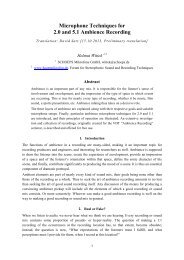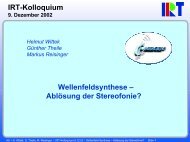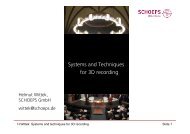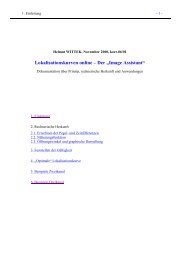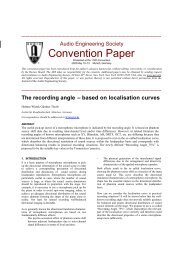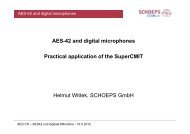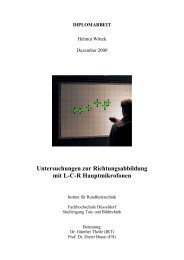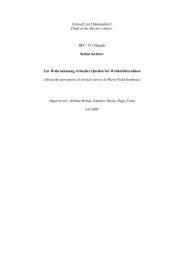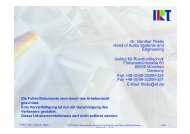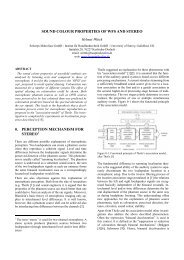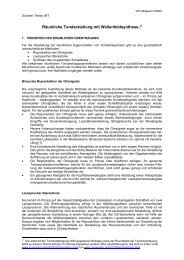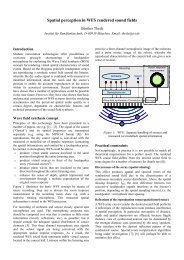on the localisation in the superimposed soundfield - Hauptmikrofon ...
on the localisation in the superimposed soundfield - Hauptmikrofon ...
on the localisation in the superimposed soundfield - Hauptmikrofon ...
You also want an ePaper? Increase the reach of your titles
YUMPU automatically turns print PDFs into web optimized ePapers that Google loves.
50<br />
4.3 Two <strong>in</strong>coherent sound sources<br />
In order to specify qualitatively <strong>the</strong> limits of <strong>the</strong> localisati<strong>on</strong> stimulus selecti<strong>on</strong>, <strong>the</strong><br />
b<strong>in</strong>aural correlati<strong>on</strong> pattern was utilised. In view of <strong>the</strong> discrim<strong>in</strong>ability of <strong>the</strong> maxima<br />
with<strong>in</strong> <strong>the</strong> time delay regi<strong>on</strong> τ, a possible discrim<strong>in</strong>ability of <strong>the</strong> source signals was<br />
deduced. In <strong>the</strong> case of two coherent sound sources, this approach can expla<strong>in</strong> a limited<br />
area of validity of <strong>the</strong> localisati<strong>on</strong> stimulus selecti<strong>on</strong>. For two <strong>in</strong>coherent sources,<br />
however, it does not provide a sufficient basis for <strong>the</strong> spatial decod<strong>in</strong>g. To illustrate,<br />
whilst two speakers positi<strong>on</strong>ed at different locati<strong>on</strong>s produce two auditory events, <strong>the</strong>y<br />
<strong>on</strong>ly create <strong>on</strong>e maximum with<strong>in</strong> each regi<strong>on</strong> of <strong>the</strong> b<strong>in</strong>aural correlati<strong>on</strong> pattern.<br />
It seems that <strong>the</strong> auditory system features much more effective processes for <strong>the</strong><br />
localisati<strong>on</strong> stimulus selecti<strong>on</strong> <strong>in</strong> <strong>the</strong> <strong>superimposed</strong> sound field. It is assumed that<br />
important selective properties of <strong>the</strong> hear<strong>in</strong>g system, <strong>in</strong>clud<strong>in</strong>g those of <strong>the</strong> locati<strong>on</strong><br />
and gestalt associati<strong>on</strong> stages, can be traced back to <strong>the</strong> effect of <strong>the</strong> hypo<strong>the</strong>tical<br />
associative stimulus process<strong>in</strong>g. Hence, <strong>the</strong> occurrence of “simultaneous auditory<br />
events” when present<strong>in</strong>g different signals over a s<strong>in</strong>gle loudspeaker is <strong>the</strong> result of <strong>the</strong><br />
stimulus process<strong>in</strong>g tak<strong>in</strong>g place <strong>in</strong> <strong>the</strong> gestalt associati<strong>on</strong> stage. Accord<strong>in</strong>gly,<br />
“simultaneous locati<strong>on</strong> associati<strong>on</strong>s” can be triggered due to similar mechanisms<br />
be<strong>in</strong>g at work <strong>in</strong> <strong>the</strong> locati<strong>on</strong> associati<strong>on</strong> stage.<br />
Both stages enable <strong>the</strong> simultaneous recogniti<strong>on</strong> of different patterns, s<strong>in</strong>ce<br />
“simultaneous auditory events” can be characterised not just by different auditory<br />
event gestalts, but also by different auditory event locati<strong>on</strong>s. This is even possible for<br />
two source signals hav<strong>in</strong>g identical amplitude envelopes if <strong>the</strong>ir spectra are<br />
sufficiently far apart (“double localisati<strong>on</strong>” of two Gaussian t<strong>on</strong>es, see BOERGER<br />
1965). The likelihood for this effect to occur is especially high if <strong>the</strong> source signals<br />
exhibit uncorrelated amplitude envelopes (cocktail party effect).<br />
The area of validity of <strong>the</strong> associati<strong>on</strong> model <strong>in</strong> <strong>the</strong> <strong>superimposed</strong> sound field is given<br />
by <strong>the</strong> discrim<strong>in</strong>ability of <strong>the</strong> source signals. In <strong>the</strong> case of coherent sound sources, <strong>the</strong><br />
po<strong>in</strong>t at which <strong>the</strong> localisati<strong>on</strong> stimuli can still be discrim<strong>in</strong>ated depends <strong>on</strong> <strong>the</strong> signal<br />
spectrum (see Secti<strong>on</strong> 4.1) as well as <strong>the</strong> result<strong>in</strong>g time difference ∆t between <strong>the</strong><br />
<strong>superimposed</strong> signals. For <strong>in</strong>coherent sources, this discrim<strong>in</strong>ati<strong>on</strong> threshold shall be<br />
def<strong>in</strong>ed by <strong>the</strong> “maximum gestalt resoluti<strong>on</strong>” of <strong>the</strong> hear<strong>in</strong>g system, which is given<br />
when <strong>the</strong> sound events are spatially c<strong>on</strong>gruent.<br />
As a result of <strong>the</strong> locati<strong>on</strong> associati<strong>on</strong> stage, every auditory event occurr<strong>in</strong>g <strong>in</strong> <strong>the</strong><br />
<strong>superimposed</strong> sound field c<strong>on</strong>ta<strong>in</strong>s some associated spatial <strong>in</strong>formati<strong>on</strong>. However,<br />
discrim<strong>in</strong>able localisati<strong>on</strong> stimuli are not just available for relatively dissimilar source<br />
signals, but, under certa<strong>in</strong> c<strong>on</strong>diti<strong>on</strong>s (see Secti<strong>on</strong> 4.1), also for spatially separated<br />
sources that emit identical signals. This is an important statement made by <strong>the</strong><br />
localisati<strong>on</strong> model.



